To Tell the Truth (1956-1968)
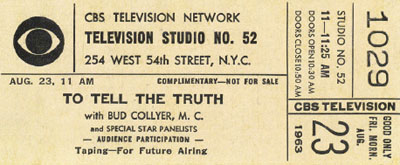
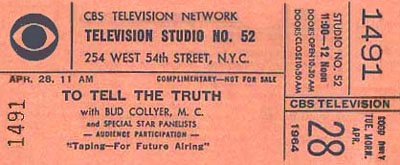
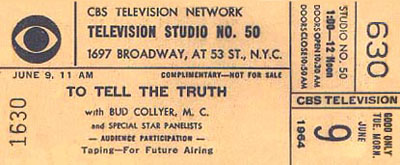
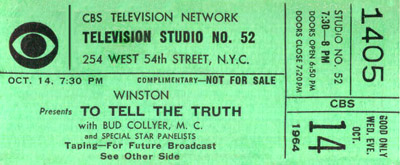
To Tell the Truth had a simple premise: Three people would come out and all claim to be the same person…a person of great interest but not someone who could be identified on sight. One was the real person. The other two were imposters who had been well-briefed by the producers. It was up to a panel of four celebrities to ask questions and try to determine which was the real person of interest.
Created by Bob Stewart, who may have created more successful game shows than anyone else, To Tell the Truth debuted in prime-time on CBS on December 18, 1956. Bud Collyer was the host and it was from the quiz show mill of Mark Goodson and Bill Todman, who were seeking to replicate the success of their What’s My Line? There were a lot of panel/game shows like this in the fifties and To Tell the Truth was unique in this regard: It was one of the few where the home audience didn’t know the answer as the panel asked questions. We at home could play right along with the panel, which usually included four of the following names: Tom Poston, Peggy Cass, Kitty Carlisle, Orson Bean, Don Ameche, Ralph Bellamy, Polly Bergen, Hy Gardner and Johnny Carson.
An odd “vibe” must have been present on the set for some years there. Host Collyer was one of the more outspoken pro-blacklisting voices in AFTRA, the TV performers’ union. He was all for purging TV of performers and staffers with “pinko” connections…but a lot of those folks worked on To Tell the Truth. Mark Goodson was among the few producers willing to stand up to demands that he drop performers who’d been fingered as unAmerican by Red Channels or other such institutions. He’d resisted demands that he fire Henry Morgan off I’ve Got a Secret and he often hired panelists like Orson Bean and John Henry Faulk who’d crossed Red Channels or AWARE. Bean and Faulk won a union election over a Collyer-backed slate on these issues and Faulk later won a major lawsuit over his blacklisting. Still, from all reports, Collyer was a professional and a gentleman to all on To Tell the Truth.
The original To Tell the Truth ended its prime-time run on May 22, 1967. A daytime version which had started in June of ’62 continued on until September of ’68. That was the end of the Collyer version but others would follow.
Camouflage (1961-1962)


One of my favorite game shows when I was a kid was Camouflage, which was hosted by Don Morrow. The premise was pretty simple: There was a drawing with a hidden picture in it. Two contestants competed to try and see who could find the hidden picture first. I remember liking the show a lot but I was ten at the time and I suspect I would have outgrown it if it had been around longer. It was revived by Chuck Barris in 1980 but it was not successful.
Dotto
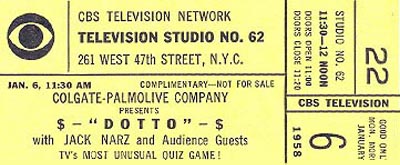
The game show Dotto aired on CBS daytime from January 6, 1958 through August 15, 1958. There was a nighttime version that ran on NBC from July 1 of that year until August 12. During the few months of its existence, it was a tremendous, highly-rated hit.
So why was it cancelled so quickly? Simple: It was rigged.
Dotto was the game show that triggered the great game show scandal. It was a simple show with two contestants competing for big prizes. On the set, each could see the same dot-to-dot puzzle. The host, Jack Narz, would ask a general knowledge question and a contestant would ring in if he or she thought they could answer it. If they were right, they banked dollars and more of the dots would be connected on the puzzle they could see. They would then have a chance to identify the image of the puzzle and if they were right, they would win the game, the money they’d banked and additional prizes. There was a little more to the game than that but not much…and it was very exciting because, in part, the producers manipulated things to make it exciting.
In May, a standby contestant named Ed Hilgemeier (nicknamed “Skinny Eddie” backstage and by the staff) watched from backstage as a woman named Marie Winn, the show’s long-running, undefeated champ, easily defeated a challenger named Yeffe Kimball Slatin. Shortly after, returning to the room where contestants were kept, Hilgemeier happened to find a notebook belonging to Winn. In it, he found the questions and answers that had just been asked on the show. Hilgemeier showed it to Slatin and together, they approached the show’s producers and threatened to go public with this evidence of rigging. The producers agreed to pay them to keep quiet.
Soon after though, “Skinny Eddie” took the matter to the Manhattan district attorney. Some reports say he was angry because the producers had declined to pay additional money he demanded. Others say he got scared that the truth would leak and he’d find himself implicated in a scandal. Either way, he blew the lid off the cover-up and it got into the press. CBS and the show’s sponsor, Colgate, looked into the matter and Dotto quickly disappeared. There was no evidence that Jack Narz was involved in the deception and his career continued, unharmed. He went on to host many other game shows, including Video Village. Not long after, it came out that some other game shows were not on the up-and-up…but Dotto was the first to fall.
Joe Garagiola’s Memory Game
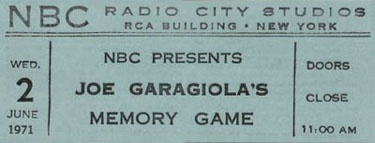
Anyone here remember Joe Garagiola’s Memory Game? That show that ran on NBC from February 15, 1971 through July 30 of the same year? The one Merv Griffin’s company created (but for some reason, didn’t put its name on) where five contestants were given all the answers to the questions in advance but only a brief time to study them, and then they had to answer as many as possible from memory? Any of this sound familiar?
Guess that explains why it didn’t last long. When it was cancelled, its host (Joe Garagiola, in case you couldn’t guess) moved over to hosting Sale of the Century and his Memory Game was quickly forgotten.
Haggis Baggis
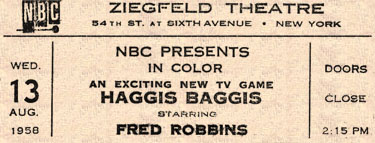
Haggis Baggis was a game show that was on for one year — from June 20, 1958 ’til June 19, 1959 — during which time it almost had more hosts than viewers. There was a prime-time version hosted by Jack Linkletter and a daytime version hosted by Fred Robbins and then Dennis James. Contestants faced a game board with a celebrity’s photo concealed behind 25 squares. They could uncover portions of the photo by naming item in different categories and the first person to identify the celeb won…and if it sounds kinda silly, it apparently was. Dennis James, who hosted an awful lot of game shows, once called it the worst one he’d ever worked on. When you consider how bad some of those programs were, you get a hint as to why, in addition to the weird name, Haggis Baggis wasn’t around for very long.
Quiz Kids (1949-1956)
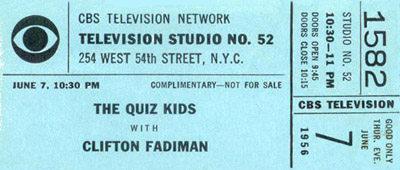
Quiz Kids was a radio show that lasted an amazingly long time when you consider that people really don’t like to listen to smart children. But that’s what it was all about: A quiz program with a panel of very bright kids who often seemed more intelligent than most of the adult viewership.
The radio version debuted in 1940, broadcast from Chicago, and continued until 1953. The TV version started in 1949 and lasted until 1956. Both versions were on and off the air multiple times and even changed networks at least once, and the host was changed several times. It was often used as a replacement show, either as a summer replacement or as a quick substitute for something that had to be cancelled in a hurry.
The kids, of course, changed from season to season. The original rules gave sixteen as the maximum age but at times, the producers would decide that younger contestants were more interesting and they’d “retire” a player well before his or her birthday.
The above ticket is from 1956, near the end of the show’s TV run. By this point, it was on Thursday evenings at 10:30 PM, requiring the kids to stay up pretty late. The host then was Clifton Fadiman, a literary figure who gained great prominence in the forties for hosting or occasionally appearing on the panels of game shows. His biggest hit on radio, which he emceed, was Information Please, one of those quiz programs where you really had to know something in order to win. On TV, he hosted many shows but the most popular was This is Show Business.
Quiz Kids was revived several times after, including a 1978 version hosted by Jim McKrell, a 1981 version hosted by Norman Lear and a 1990 version hosted by Jonathan Prince.
Love Experts, The
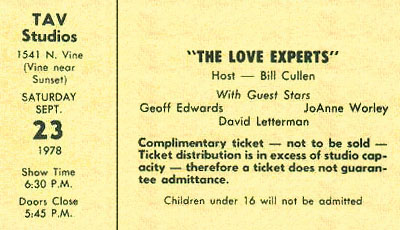
Another in the endless series of game shows hosted by Bill Cullen, The Love Experts was an awkward attempt to combine a game show with a talk/advice show. In each episode, three contestants would appear — one after the other — to talk about their romantic problems and to seek advice from that day’s panel of four celebrities. The expertise was a little dicey. Even assuming you’d want to talk about your love life on national TV, would you want counsel from Joanne Worley? Soupy Sales? Elaine Joyce? Nipsey Russell? Peter Lawford? At least some of those people should have been seeking advice instead of giving it.
As you can see from the above ticket, even David Letterman was one of the alleged experts. This was from a brief period when Mr. Letterman was making the rounds of game shows, usually acting like he didn’t want to be there, wherever he was. I suspect his advice to the lovelorn, even if he didn’t express it on the air, was to not seek advice from people like himself.
Producer Bob Stewart had previously taped and been unable to sell a pilot of this show hosted by Jack Cassidy…and hey, there’s a guy who didn’t have a single problem in his love life. When Cullen was brought in, he was doing double-shifts, simultaneously hosting The $25,000 Pyramid, also produced by Stewart. Bill did his best to keep the proceedings moving, and the show actually lasted a whole year in syndication (September of ’78 through September of ’79) though it didn’t air in many of the major markets. The “game” part came at the end when the celebs would vote to award a big prize to the person who had the most interesting story, which generally meant the most pathetic one. My main recollection of the program is that the romantic problems that the contestants offered up sounded phony and contrived. If they weren’t fabricated by the show’s producers, they were probably phonied up by the contestants hoping to win the big prize.
I’ve Got A Secret (1976)
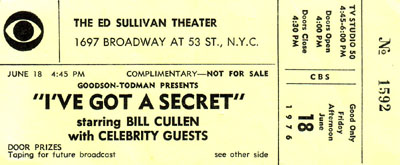
In 1976, CBS revived the long-running game show I’ve Got A Secret for what turned out to be a short-running “filler” in their schedule. Bill Cullen, who’d been a panelist on the first version, moved over to the host’s chair. Henry Morgan, who’d also been a panelist on the original version, returned to his old chair and he was joined by Richard Dawson, Elaine Joyce and New York entertainment reporter Pat Collins. In format, it was identical to I’ve Got A Secret as hosted by Garry Moore but the longevity was not there. The Cullen version lasted but six weeks and since it was on opposite Happy Days at the peak of that show’s popularity, almost no one tuned in or even knew it was on.
Cullen was, of course, a fine host…probably the best choice they could have made since Garry Moore, who was then hosting the daytime To Tell The Truth, declined the post. (Not long afterwards, Moore retired completely from television.) On the old show, Cullen and Morgan had occasionally filled in for Moore but neither had gotten the position when ol’ Garry left that version. Morgan, it was felt, was better suited to be a panelist where his acerbic remarks — which occasionally suggested that something on the show was stupid — were more appropriate. Cullen was, of course, a great host but at the time of Moore’s departure from the original show, Bill was also hosting The Price is Right on ABC. That network didn’t mind him continuing as a panelist on a rival web’s show but discouraged him hosting over there…so Steve Allen took over I’ve Got A Secret.
There had also been another problem with having Cullen take over for Moore. It was a poorly-kept secret that Bill Cullen, star of countless TV programs, had a bad limp, the result of a childhood bout with polio. He didn’t demand that it never be mentioned (although some articles and bios did blame it on an auto accident) but suggested that no special attention be called to it, and that, of course, he not be placed in situations where he’d have to stand or walk a lot on camera. The shows he did were generally designed to accommodate this. He would usually not make an entrance at the beginning of the show or if he did, it would only be a step or two. If he had to walk — as he did when he entered as a panelist on the Moore-hosted To Tell The Truth — the director would cut around the action as much as possible so as to not show Cullen limping about the stage.
The producers of the original I’ve Got A Secret used Cullen once or twice as a fill-in host when Moore was away but it was not satisfactory. The nature of the show, with stunts and demonstrations of various contestants’ secrets, demanded a host who could work on his feet. When the ’76 version of the show came about though, it seemed more important to try and recapture the spirit of the earlier series so they decided to have Cullen preside even if that meant limiting the physical segments. It probably seemed like a good trade-off but in the end, it really didn’t matter. Nobody was watching.
Thanks to Kenneth Johannessen for the ticket scan.
Tic-Tac-Dough (1956-1959)
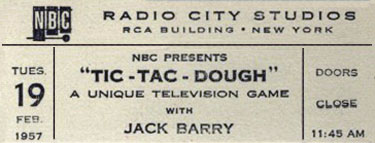
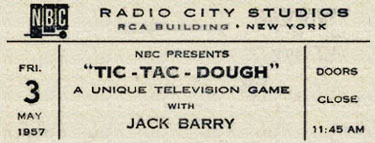
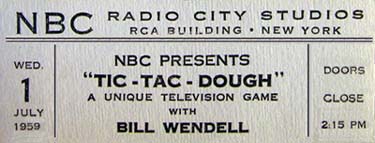
Tic-Tac-Dough had a long, checkered history. Produced and originally hosted by Jack Barry, it debuted on NBC daytime on July 30, 1956. Barry was busy with his company’s prime-time hit and he eventually handed hosting chores off to Gene Rayburn. Announcing Legend Bill Wendell was the announcer and when Rayburn moved on in 1958, Wendell took over as host, continuing until this run of the show did its final broadcast on October 23, 1959. A prime-time version, hosted by Jay Jackson and later by Win Elliot, ran from September 12, 1957 until December 29, 1958.
What killed Tic-Tac-Dough was the scandal that Barry and his line producer, Dan Enright, were rigging their shows. Most of the outrage was over their other prime-time series, Twenty-One, but there was plenty of evidence that the outcome of many a game of Tic-Tac-Dough was prearranged. In particular, a Tic-Tac-Dough contestant named Kirsten Falke was subpeonaed by a government investigation and she admitted that one of the show’s producers, Howard Felsher, coached her on how to win and gave her answers in advance. The prime-time version was yanked off the air but NBC attempted to keep the daytime version around for a time, swearing that it had been cleaned up and was now on the level. It may have been but audiences stopped watching. Perhaps they didn’t believe that the show was now honest or maybe it just reminded them how they’d been deceived.
But that was not the end of Tic-Tac-Dough. It came back in a daytime version on CBS in 1978 and when that was cancelled, it shifted to syndication where it had a long and healthy run from 1978 through 1986. It then came back again for a brief run in 1990.
How did one play Tic-Tac-Dough? Simple. Two contestants competed, one designated as “X” and one designated as “O,” just as in tic-tac-toe. Each of the nine boxes on a tic-tac-toe grid had a category assigned to it and a player could “win” that box by correctly answering a question in that category. Get three in a row and you win. It was very simple, which perhaps explains the game’s long run.
Price is Right, The (1956-1965)
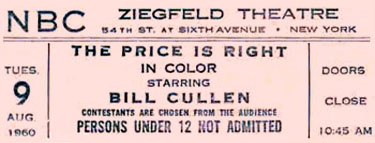
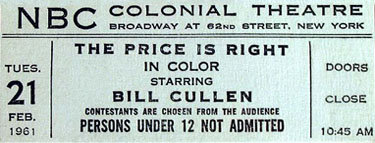
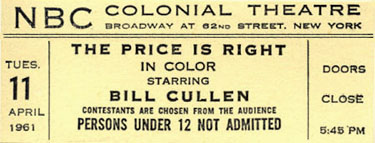

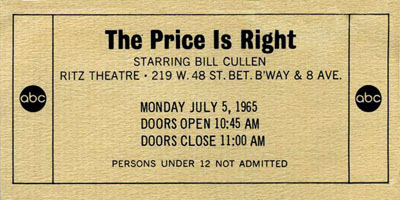
The original version of The Price is Right was a big hit, owing mainly to the twinkling hostmanship of emcee Bill Cullen. It was basically a giveaway show: Four contestants, apparently chosen primarily for their excitability, would “bid” on various items, trying to guess the manufacturer’s suggested retail price. The one who got the closest without going over would win the item plus (usually) an array of bonus prizes.
The show had three main appeals. One was that you at home could play along, seeing how close you could come to guesstimating the prices. The second appeal was watching the winners going through fits of ecstasy and hysteria to score a free refrigerator or trip to the Bahamas. And the third appeal was Cullen, who was easily one of the cleverest, most congenial hosts to ever preside over a game show.
William Lawrence Cullen was born in Pittsburgh, Pennsylvania in 1920 and broke into radio there during his teen years. By 1946, he was the host of the radio game show, Winner Take All, starting an amazing run of game show jobs both as host and panelist. On radio and television, the list included Act It Out, I’ve Got a Secret, Bank on the Stars, Professor Yes ‘n’ No, The Joker’s Wild, Sports Cavalcade, Blankety Blanks, The Love Experts, The $25,000 Pyramid, Blockbusters, Three on a Match, Chain Reaction, Meet Your Match, To Tell The Truth, Child’s Play, Name That Tune, Where Was I?, Down You Go, The Name’s The Same, Who’s There?, Eye Guess, Why?, Give and Take, Hot Potato, Pass the Buck, Winning Streak, How Do You Like Your Eggs?, Place the Face and You’re Putting Me On.
The Cullen version of The Price is Right aired on NBC in daytime from 1956 until 1963, then shifted to ABC where it lasted until 1965. A weekly prime-time version aired from 1957 until 1964, also traversing both networks. As you can see from the above tickets, they moved around. The first ticket is for the Ziegfeld Theater, which NBC acquired in 1955. It had previously housed musicals including the original Kiss Me Kate and Show Boat. (The last legit offering there was an original musical by Lumpy Brannan, who went on to portray Mr. Green Jeans on the Captain Kangaroo TV show.) A few years before NBC sold the theater and it reverted to Broadway fare, The Price is Right moved to the Colonial and then when the show migrated to ABC, to the Ritz, which is now known as the Walter Kerr Theater.
In 1972, the production company (Goodson-Todman) decided to try and revive The Price is Right. It only took a few run-throughs for Mark Goodson to decide that the format was hopelessly outdated and that a major facelift was in order. The game that had been the core of the Cullen version was pared down to a quick pricing round, via which audience contestants earned the right to come up on stage and play the real game. And the rest is history…






